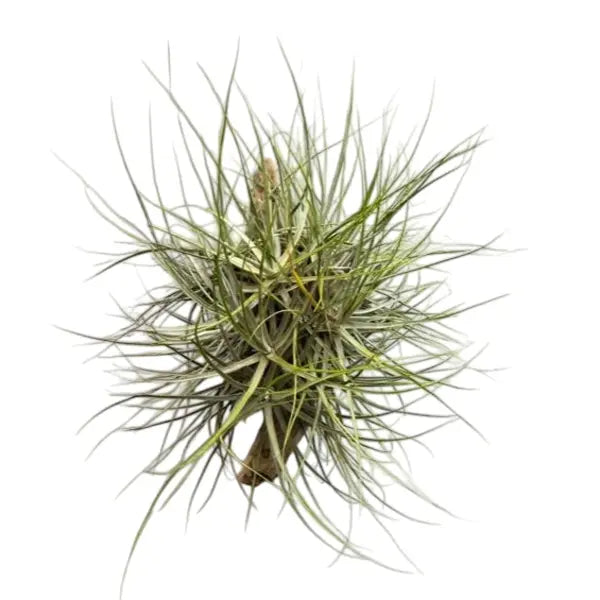
Tillandsia Schiedeana - Giant Form
Selling Size : Third Image | Single Plant | Secure Packing
It seems there might be a slight misunderstanding in the term "scrab plant." Based on the search results, it's highly probable you're referring to either:
Here's a comprehensive care guide for your Tillandsia schiedeana 'Giant Form':
1. Light:
Bright, indirect light is ideal. This plant thrives in sunny environments, but direct, scorching sun, especially during the hottest parts of the day, can lead to burning and drying of the foliage.
Indoors: Place it near a bright window (east or west-facing are often good). A south-facing window might be too intense without some sheer curtain for diffusion.
Outdoors: If growing outdoors, choose a spot with partial shade, like under a tree, on a verandah, or in a shade house.
Trichomes: The silvery fuzz (trichomes) on the leaves indicate it can tolerate brighter light and less humidity than green-leaved Tillandsias.
2. Watering:
Regular watering is crucial. While air plants don't grow in soil, they need consistent moisture.
Soaking is the preferred method: Submerge the entire plant in room-temperature water (rainwater, filtered water, or distilled water is best; avoid chlorinated tap water) for 5-20 minutes, depending on the environment and how dry the plant is. For T. schiedeana 'Giant Form', a 10-20 minute soak once a week is a good starting point.
Misting: In between soaks, you can mist the plant 2-3 times a week, especially in dry environments. Misting alone is usually not sufficient for complete hydration.
Crucial Drying: After any watering, gently shake off excess water and allow the plant to dry completely within 1-3 hours. Good air circulation is vital for this. Never let water sit in the base of the plant, as this will lead to rot. Watering in the morning is recommended so the plant can dry throughout the day.
Signs of Thirst: Curling or wrinkling leaves indicate the plant needs water.
3. Air Circulation:
Excellent air circulation is paramount. This is often overlooked but is as important as watering. Without good airflow, especially after watering, the plant is highly susceptible to rot.
Avoid enclosed containers: Do not keep Tillandsia schiedeana 'Giant Form' in terrariums or glass globes with poor ventilation. If you use a terrarium, ensure it's open-top and provides ample airflow.
Placement: Place your plant where there's a gentle breeze or good air movement.
4. Temperature:
Warm climates are preferred. The ideal temperature range is generally between 10-32°C (50-90°F).
Avoid frost: Tillandsia schiedeana is not frost-hardy and should be brought indoors if temperatures drop below 4-5°C (39-41°F). They can tolerate brief periods near 0°C (32°F) if dry and sheltered.
Protect from hot air: Keep the plant away from direct drafts from heaters or air conditioners.
5. Humidity:
Moderate to high humidity is beneficial. While T. schiedeana is relatively tolerant of drier conditions due to its trichomes, it appreciates ambient humidity between 40-70%.
Increasing humidity: If your indoor environment is dry, consider using a humidifier, misting more frequently, or grouping the plant with other plants to create a microclimate.
6. Mounting and Display:
Tillandsia schiedeana 'Giant Form' is an epiphyte and should not be planted in soil.
You can mount it on various non-water-retaining substrates like cork bark, driftwood, rocks, or shells.
Secure it with coated wire, fishing line, or a strong, plant-safe adhesive.
Do not cover the base of the plant with moss, as this can trap moisture and cause rot.
This species tends to form attractive clumps over time, and can look great hanging.
7. Fertilization:
Fertilize sparingly. Use a bromeliad-specific fertilizer or a balanced, water-soluble fertilizer diluted to 1/4 or 1/2 strength.
Apply 1-2 times a month during the active growing seasons (spring and summer) and once a month in winter.
Since most Tillandsias absorb nutrients at night when their stomata are open, fertilizing in the evening can be more effective.
Avoid fertilizers with copper, boron, or zinc, as these can be harmful.
8. Propagation:
Tillandsia schiedeana 'Giant Form' can be propagated from offsets, also known as "pups," which are baby plants that emerge around the base of the parent plant, especially after flowering.
Wait until the pups are at least 1/3 to 1/2 the size of the parent plant before separating them. This ensures they are strong enough to survive on their own.
You can gently twist them off or use a clean, sharp knife to separate them from the mother plant.
You can also let the pups grow with the parent plant to form a beautiful clump.
Common Problems and Solutions:
Dried up plant: Adjust watering frequency. If it's entering dormancy due to decreasing daylight, reduce watering and wait for new growth.
Withering leaf tips: Often a sign of low humidity. Increase misting or use a humidifier.
Rot (soft, mushy base): Caused by overwatering or insufficient air circulation. This is often fatal. Ensure proper drying after watering and good airflow.
By following these guidelines, your Tillandsia schiedeana 'Giant Form' should thrive and become a beautiful addition to your collection!

